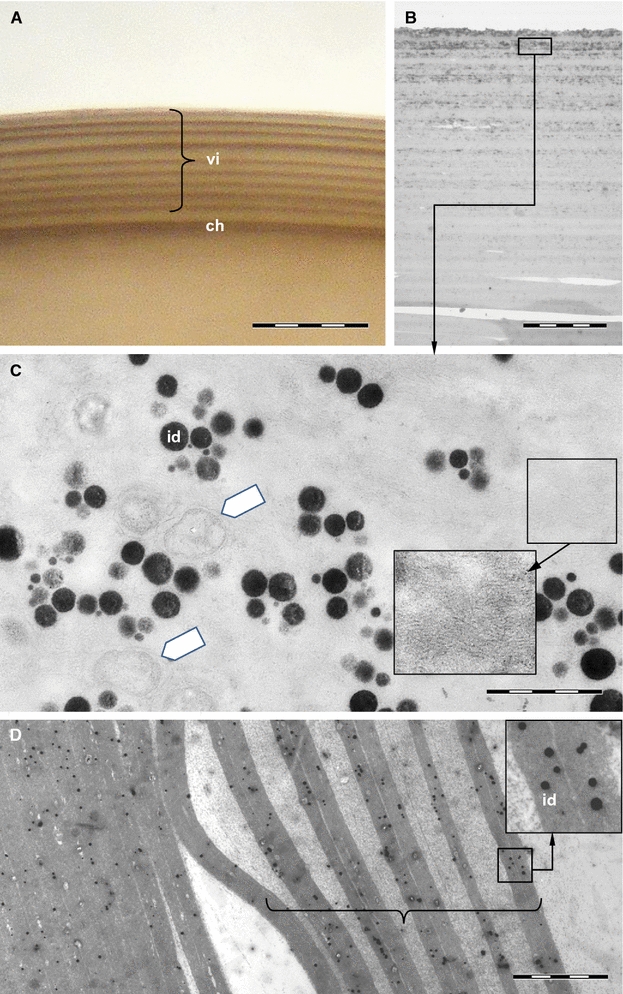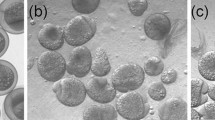Synopsis
Hatching in Coregoninae embryos is not closely connected with a determined stage of embryonic development. Electrical stimulation (AC) induced precocious hatching, and incubation at low temperature caused delay of hatching compared to controls. Embryos hatched precociously had shorter bodies and larger yolksacs than those whose hatching was normal or delayed. This was accompanied by respective changes in duration of the eleutheroembryonic phase (DEP) — inCoregonus lavaretus DEP decreased from 7 days in embryos hatched precociously to 0 days in embryos from delayed hatching.
Similar content being viewed by others
References cited
Alderdice, D.F., W.P. Wickett & J.R. Brett. 1958. Some effects of temporary exposure to low dissolved oxygen levels on Pacific salmon eggs. J. Fish. Res. Board Can. 15: 229–250.
Balon, E.K. 1975. Terminology of intervals in fish development. J. Fish. Res. Board Can. 32: 1663–1670.
Balon, E.K. 1985. Early life histories of fishes: new developmental, ecological and evolutionary perspectives. Dr W. Junk Publishers, Dordrecht. 280 pp.
Blaxter, J.H.S. 1969. Development: eggs and larvae. pp. 177–252. In: W.S. Hoar & D.S. Randall (ed.) Fish Physiology, Volume III, Reproduction and Growth, Bioluminescence, Pigments, and Poisons, Academic Press, New York.
Braum, E. 1967. The survival of fish larvae with reference to their feeding behaviour and the food supply. pp. 113–131. In: S.D. Gerking (ed.) The Biological Basis of Freshwater Fish Production, Blackwell Scientific Publications, Oxford.
Brooke, L.T. & P.J. Colby. 1980. Development and survival of embryos of lake herring at different constant oxygen concentrations and temperatures. Prog. Fish - Cult. 42: 3–9.
Dabrowski, K. 1975. Point of no return in the early life of fishes. An energetic attempt to define the food minimum. Wiad. Ekol. 21: 277–293 (in Polish).
DiMichele, L. & M.H. Taylor. 1981. The mechanism of hatching inFundulus heteroclitus: development and physiology. J. Exp. Zool. 217: 73–79.
Grudniewski, C. 1980. Effect of starvation on hatch survibability of vendace (Coregonus albula L.), whitefish (Coregonus lavaretus L.) andCoregonus peled Gmel. Zesz. Nauk. ART Olszt. 10: 1–38 (in Polish).
Hagenmaier, H.E. 1974. Zum Schlüpfprozess bei Fischen VI. Entwicklung, Struktur und Funktion der Schlüpfdrüsennzellen bei der Regenbogenforelle,Salmo gairdneri Rich. Z. Morph. Tiere 79: 233–244.
Heming, T.A. 1982. Effects of temperature on utilization of yolk by chinook salmon (Oncorhynchus tshawytscha) eggs and alevins. Can. J. Fish. Aquat. Sci. 39: 184–190.
Iuchi, I. & K. Yamagami. 1976. Induction of a precocious secretion of the hatching enzyme in the rainbow trout embryo by electric stimulation. Zool. Mag. 85: 273–277.
Jezierska, B., M. Korwin-Kossakowski & G. Jowko. 1979. The effect of starvation and temperature conditions on vendace (Coregonus albula L.) larvae. Pol. Arch. Hydrobiol. 26: 387–395.
Luczyński, M. 1984. Temperature and electric shock control the secretion of chorionase in Coregoninae embryos. Comp. Biochem. Physiol. 78A: 371–374.
Luczyński, M. 1986. Optimal thermal conditions in the early ontogeny of Coregoninae. Acta Acad. Agricult. Olsten. (in Polish) (in press).
Luczynski, M. & J. Dettlaff. 1985. Precocious hatching in Coregoninae embryos by electric stimulation. Z. Angew. Ichthyol. 1: 157–164.
Luczyński, M. & A. Kirklewska. 1984. Dependence ofCoregonus albula embryogenesis rate on the incubation temmperature. Aquaculture 42: 43–55.
Luczyński, M., W. Wojtaszek & A. Kirklewska. 1986. The influence of egg size and thermal conditions of incubation on the body length and the yolk sac volume of vendaceCoregonus albula L. eleutheroembryos. Acta hydrochim. hydrobiol. 14: 175–183.
O'Brien, S., S. Visaisouk, R. Raine & D.F. Alderdice. 1978. Natural convection: a mechanism for transporting oxygen to incubating salmon eggs. J. Fish. Res. Board Can. 10: 1316–1320.
Schoots, A.F.M. 1982. Enzymatic hatching of fish embryos. Ph. D. Thesis, Katholieke Universiteit, Nijmegen. 147 pp.
Vuorinen, J. 1984. Biochemical genetic studies on salmonid populations. Ph. D. Thesis, University of Joensuu, Joensuu. 68 pp.
Yamagami, K. 1981. Mechanisms of hatching in fish: secretion of hatching enzyme and enzymatic choriolysis. Amer. Zool. 21: 459–471.
Yamagami, K., M. Yamamoto, I. Iuchi & S. Takeuchi. 1983. Retardation of maturation — and secretion — associated ultrastructural changes of hatching glands in medaka embryos incubated in air. Annot. Zool. Japan. 56: 266–274.
Yamamoto, M., I. Iuchi & K. Yamagami. 1979. Ultrastructural changes of the teleostean hatching gland cell during natural and electrically induced precocious secretion. Develop. Biol. 68: 162–174.
Author information
Authors and Affiliations
Rights and permissions
About this article
Cite this article
Luczyński, M., Kolman, R. Hatching ofCoregonus albula andC. lavaretus embryos at different stages of development. Environ Biol Fish 19, 309–315 (1987). https://doi.org/10.1007/BF00003231
Received:
Accepted:
Issue Date:
DOI: https://doi.org/10.1007/BF00003231




